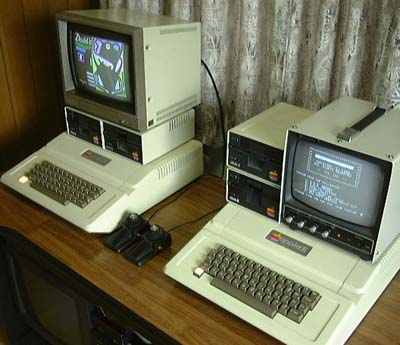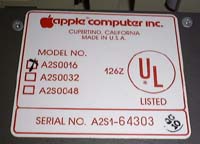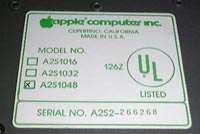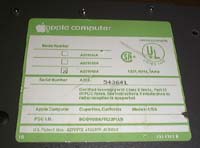
My appleII Notes-2
My AppleII Notes-2
99/5/5 2
standard machines

I arranged the two systems, which arrived the other day, side by side on the
desk. One is an Original Apple II (see right for My Apple II Notes - 1) and the
other is a Standard Apple II. The Apple II model, which appeared in April 1977,
changed to the Apple II Plus in the fall of 1979. This Apple II Plus is a model
that is equipped with an auto start ROM which features 10K Basic (Basic with
floating-point known as AppleSoft Basic), thus
it has the following characteristics: when powered on, it turns to basic mode,
and when a disk drive is mounted it boots up automatically.
In the Plus model, the debugging
function of machine language programs such as mini assembler, single step, and
trace, etc., which were in the standard model, had been removed. For this
reason, Apple sold standard machines for the same price of Plus machines for
users who liked standard machines, for a period of one to one and a half years
since the fall of 1979. The machine to the left is that machine.
Comparing these two machines, although the mother board is the same as in Rev.1,
there is a difference in model of power supply, keyboard and the memory type
selector, which can be switched between 4K and 16K in Original machine but is
fixed to 16K in the standard machine.
The original standard system on the right seems to have been rarely used, with
an Applesoft Basic card, Dos is 3.2.1, and the Disk II controller still has the
original 13 sector specification. The monitor, a Sanyo VM 4209, is a 9 inch
monochrome monitor. Since I was able to acquire the manual this time, I could
get to know many features of this monitor. It is designed to connect up to
three units to one video, and termination switches have been used to match the
output level. According to the manual, it seems there was also a dedicated rack
mount assembly.
The main body (left) was passed on from a California programmer. Although the
original is a 16K system, the memory has been expanded, the ROM has been
exchanged for a Plus specification, and an Integer Basic card has been
installed. On the controller card of Disk II, 13 sector ROM and 16 sector ROM
have been installed, so that it can be switched between 13 sectors / 16 sectors
with the snap of a switch. The Toray color monitor TM - 113V (A) was recently
acquired in Japan. In the section on Apple IIJ-Plus, I introduce the same type
of monitor, but the one that I acquired this time was the one that was
manufactured in the January-June quarter of 1982, so it is slightly newer than
the one I introduced in the IIJ-Plus section. They look very good both in color
and appearance.
I am greatly interested in two of the standard machines lined up in our house
that were manufactured about 20 years ago.
99/5/5 History of Back Panel Labels
I examined various Apple II back panels from the original standard Apple II to
the latter term Apple II Plus.
 |
Original Standard AppleII This label is a simple black design. Initially, there were two kinds for the US, and PAL and SECAM compatible version for Europe. There were four types, 4K, 16K, 32K and 48K, due to memory differences. Applesoft Basic tapes come with machines with 16K or more. The last two digits differ depending on the number of installed memories. (Estimated manufacturing date as of the end of 1978) |
 |
AppleII Standard Serial No. A2S1 - 64303. A standard machine that was sold alongside the Apple II Plus. The serial number starts with A2S1 which indicates that it is a standard model. The model number is also A2S00 -. The color of the label is red, and it has a large design in keeping with the earlier Apple II Plus, Bell & Howell. (Estimated manufacturing year 1979 - 80) |
 |
Serial No. A2S2 - 266268. The Apple II Plus is given a serial number of
A2S2. The model number is A2S10 -. The label color is green. (Estimated
manufacturing year 1979 - 80) |
 |
Bell & Howell AppleII Plus Serial No.A2S3 - 13 9 0 0. The B&H model begins with the number A2S3, and the model number is also assigned the number B at the end of the A2S10-- signifying Bell & Howell. The label is black and large. (Estimated manufacturing year, autumn 1979) |
 |
AppleII Plus(Middle term) Serial No. A2S2 - 589 19. The Apple II Plus model begins with the number A2S2. The model number is A2S10 -. The color of the label is green. The Apple IIJ - Plus also has the same nameplate, but the Toray seal is also attached, which shows that was Toray exported to Japan. (Estimated date of manufacture 1980) |
 |
Europlus Serial No.I2S2 - 660655. Ireland factory. In Irish machines, Ireland's I comes before A2S2, and it seems that the serial number is also headed with a 6. The color of the label is green. It is estimated that it was manufactured at around the same time as that of the above machine. (Estimated production year 1980 - 81) |
 |
AppleII Plus(Lator Revision) Serial No. A2S2-543641. A later model of the Apple II Plus has this label design. Since Apple released the Apple IIe in January 1983, models manufactured between 1981 to 1982 are presumed have this large green label. For Model number A2S10 the letter A is attached. (Estimated manufacturing year 1981-82) In June 1983, the cumulative sales volume of Apple II reaches 1 million units. |